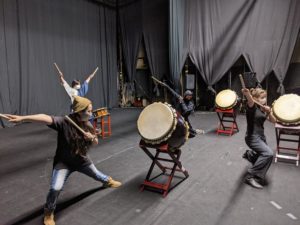Architecture and Historical Buildings of the Castle Town

Matsumoto City is famous for its feudal castle, whose achitecture and history represents all the greatest things that characterize Japan. But this ancient castle and its architecture is only one of many historical buildings within the city. Discover the architecture and the very tangible historical buildings of the castle town.
Matsumoto Castle
- Year of construction: 1593
With over 400 years of history, Matsumoto Castle is 1 of only 5 castles designated a “National Treasure” of Japan. Matsumoto Castle’s architecture is characteristic of the Sengoku period (Warring States Period). The castle tower’s elegant, imposing appearance and dominant black outer walls earn it the nickname “Crow Castle”. The castle’s history is intrinsically linked to the Samurai’s history.

Kaichi School
- Year of construction: 1876
Kaichi School was first built near the Metoba River. The building was used as a school until 1963 when it was moved to the current location. In 2019, it became the first modern school building to be designated as a National Treasure”. The architecture reassembles Western style in appearance, yet relies on traditional Japanese construction techniques. The facade of the school is a prime example of this blended architecture. The bay windows are made with glass imported from France. The tiled roof is traditional Japanese. And the carved dragon is clearly Far-Eastern with a touch of Buddhism.

Satoyama Villa Honjin
- Year of construction: 1913
Located in Shiga-mura and facing the old Zenkoji Road, Satoyama Villa Honjin is an historic building that used to be an exclusive inn for Matsumoto Caste Lords needing a rest stop during the Edo period. The original building burned down in 1908 and was restored to its original state in 1913. The building is a historical marvel and its authentic architecture will take you on a genuine journey back in time!

Kawakami Building
- Year of construction: 1925
The building is a two-story wooden structure with a Western-style facade. It was used as a doctor’s office until the 1950s and then became an architectural design office. The vertical lines of the building are emphasized by the vertical windows on the upper and lower floors. And the stained glass windows with flowers and geometric patterns above the entrance door are reminiscent of Art Nouveau. Nearby is located a small local sake brewery as well as an old private house built in 1887 and used as a traditional gourmet restaurant.

Ikegami-tei storehouse
- Year of construction: Meiji Era (Unknown)
Located next to the Genchi well, this storehouse was built as a rice storehouse in the Meiji era. The exterior hip walls are not laminated, but a modern combination of troweled and washed mortar. The roof is a hipped roof suggesting that it was built with a Western style in mind. It has been used for many years as a venue for the “May of Crafts”. This event held every year around the Agatanomori Park.

Agetsuchi Theater
- Year of construction: 1960
Located in Agetsuchi-machi neighborhood, this movie theater was built in 1960 and was called “Matsumoto Piccadilly” at that time. The facility was renovated by local theatrical artists and citizen volunteers and has become a popular “theater of their own.” In 2018, the theater was renamed the Agetsuchi Theater, and is currently undergoing further revitalization as a theater with deep roots in the local community.

And more…











Author Profile

Latest entries
 Art2024-01-25Drift Into the Seductive World of “Ukiyo-e” While in Matsumoto
Art2024-01-25Drift Into the Seductive World of “Ukiyo-e” While in Matsumoto Events2024-01-10The Ameichi Festival: Matsumoto’s Edo Period Celebration That Continues Today
Events2024-01-10The Ameichi Festival: Matsumoto’s Edo Period Celebration That Continues Today Notification2023-12-14New Year’s Holiday Closure Notification: Matsumoto Castle & More
Notification2023-12-14New Year’s Holiday Closure Notification: Matsumoto Castle & More Other2023-11-27United in Friendship: Matsumoto’s Sister Cities Within Japan
Other2023-11-27United in Friendship: Matsumoto’s Sister Cities Within Japan















2 thoughts on “Architecture and Historical Buildings of the Castle Town”